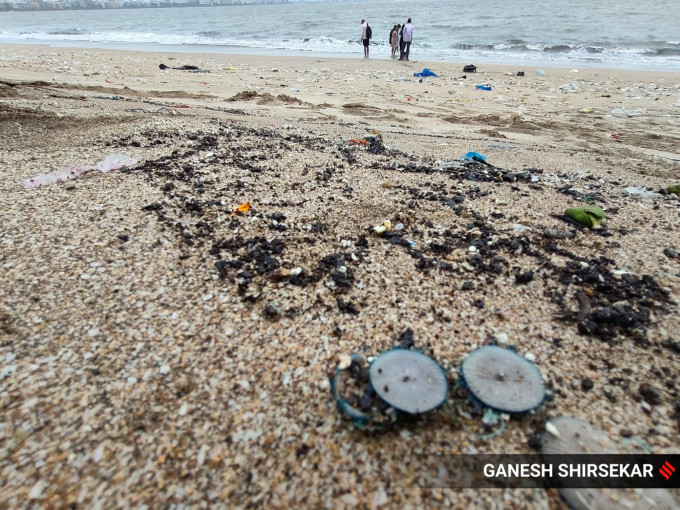Vibrant blue button jellyfish with stinging tentacles wash up on Mumbai’s Girgaon Chowpatty: Why are they appearing more frequently?
Beachgoers at Mumbai’s Girgaon Chowpatty were once again greeted by an unusual visitor — blue button jellyfish. These jellyfish, known for their vibrant blue colour and stinging tentacles, have been appearing more frequently along shorelines, raising questions about the environmental factors contributing to this phenomenon.
Indian Express photographer Ganesh Shirsekar, who managed spot and click pictures of these marine creatures, said: “I found them scattered along Girgaon Chowpatty beach. They usually wash up around Ganpati Visarjan each year, but this time, they arrived much earlier.”

While the sight of these marine creatures can be visually striking, their presence often signals changes in oceanic conditions that may impact both marine life and human activities. Several factors are believed to play a role in the proliferation of jellyfish blooms.
Environmental conditions typically lead to the blooms of jellyfish
Vishal Kumar CEO at Waste Warriors, says, “Jellyfish blooms, including those of the blue button jellyfish (also known as Porpita Porpita), are typically influenced by a combination of environmental conditions such as water temperature, salinity, ocean currents, and nutrient availability. These conditions create favourable environments for jellyfish to reproduce and thrive.”
Rising sea temperatures, he adds, often linked to climate change, can accelerate their reproduction rates and extend their seasonal presence. Warmer waters can also lead to the migration of jellyfish from their usual habitats to new areas, resulting in more frequent blooms near coastal regions.
He continues, “High levels of nutrients, particularly nitrogen and phosphorus, can lead to plankton blooms, which are the primary food source for jellyfish. When these plankton populations increase, jellyfish populations often follow. Changes in ocean currents and wind patterns also play a crucial role in the movement of jellyfish.”
 Regular monitoring of jellyfish populations and environmental conditions can help predict jellyfish blooms. (Express photo by Ganesh Shirsekar 29/08/2024)
Regular monitoring of jellyfish populations and environmental conditions can help predict jellyfish blooms. (Express photo by Ganesh Shirsekar 29/08/2024)
Why are blue button jellyfish appearing more frequently near shorelines?
The increasing frequency of blue button jellyfish sightings near shorelines can be attributed to a variety of factors that are particularly relevant in urban coastal environments, according to Kumar:
– Coastal Urbanisation: Urban development along coastlines often leads to alterations in natural habitats. The construction of piers, breakwaters, and other coastal structures can potentially trapping jellyfish in bays and near shorelines.
– Pollution and Eutrophication: Urban runoff, sewage discharge, and agricultural runoff can increase the nutrient content in coastal waters, leading to eutrophication. This nutrient overload causes plankton blooms, providing ample food for jellyfish and thereby promoting their proliferation.
– Climate Change: Human-induced climate change contributes to warming oceans, which is one of the major drivers of jellyfish blooms. The increase in ocean temperatures, along with acidification, has altered the distribution of marine species.
– Overfishing: The depletion of natural predators of jellyfish, such as certain fish species and sea turtles, due to overfishing, can lead to an increase in jellyfish numbers.
Measures to mitigate the risks associated with jellyfish blooms
Managing jellyfish blooms and mitigating risks for beachgoers require a combination of public awareness, coastal management strategies, and broader environmental actions:
– Public Awareness and Education: Informing the public about jellyfish risks, particularly during bloom seasons, can help prevent stings and injuries. Beachgoers should be educated on recognising jellyfish, understanding safe swimming practices, and knowing how to treat stings.
– Monitoring and Forecasting: Regular monitoring of jellyfish populations and environmental conditions can help predict jellyfish blooms. This information can be used to provide early warnings to the public and manage beach access during high-risk periods.
– Environmental Management: Reducing pollution and improving waste management practices along coastlines can help mitigate some of the factors contributing to jellyfish blooms. Controlling nutrient runoff from agriculture and urban areas can help prevent the eutrophication that often leads to jellyfish blooms.
– Promoting Sustainable Fishing Practices: Encouraging sustainable fishing can help restore the natural balance of marine ecosystems, preserving jellyfish predators and competitors. A balanced ecosystem is less likely to experience unchecked jellyfish blooms.
📣 For more lifestyle news, click here to join our WhatsApp Channel and also follow us on Instagram
Disclaimer: The copyright of this article belongs to the original author. Reposting this article is solely for the purpose of information dissemination and does not constitute any investment advice. If there is any infringement, please contact us immediately. We will make corrections or deletions as necessary. Thank you.
